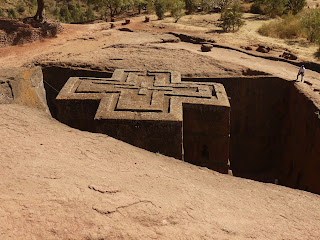A few weeks ago, I found myself with a free weekend in Ethiopia in between Friday and Monday meetings with the Ministry of Health there. I had been hearing about the rock-hewn churches of Lalibela basically since I moved to Uganda, and I heard you could get to them from Addis Ababa for just $100, so I planned a quick Saturday morning to Sunday morning trip...alone. While the thought of even eating a meal alone used to scare me, after almost a year of traveling constantly and often without company, the prospect of a whole trip by myself now seems like no big deal at all.
Lalibela is a town in the almost Arizona-esque mountains of Northern Ethiopia that is a center of religious pilgrimage in the Ethiopian Orthodox Church. The 12 churches were constructed in the 1100s as a sort of "Jerusalem" for the Ethiopian church. They are all monolithic (formed of a single block of stone) or semi-monolithic and are carved directly into the mountains. It is awe-inspiring imagining their construction hundreds of years ago.
One of the hardest parts of being in Lalibela was the feeling of being surrounded by some of the deepest poverty I have ever witnessed. I had never seen a goiter before being in Lalibela, and I also don't think I have ever seen so many people who just simply looked hungry. My guide told me that in their region of Ethiopia, they are only able to grow enough food to sustain themselves four months of the year, and the rest of the year they rely on food aid. It was jarring to be in a place with such incredible natural beauty and such an amazing historical treasure that was so deeply, clearly poor.
One of the strangest things about visiting historical sites in Africa is the haphazard way precious things are often displayed and the attempts local organizations make to please UNESCO. While the exteriors of the churches in Lalibela were spectacular, the interiors were full of ratty cloth, unframed paintings from 500 years ago, and creepy fluorescent lighting. These are probably the nicest interior shots I saw while there. My guide is in the second photo - he became a guide after the communist government was overthrown and he lost the political position he had gained as a member of the party. I think he is still slightly bitter 20 years later.
Overall, it was a pretty spectacular way to spend 24 hours and just over $100. The most amazing (and most characteristic of the monolithic style) church, the Church of St. George, is pictured below from 3 angles.
Lalibela is a town in the almost Arizona-esque mountains of Northern Ethiopia that is a center of religious pilgrimage in the Ethiopian Orthodox Church. The 12 churches were constructed in the 1100s as a sort of "Jerusalem" for the Ethiopian church. They are all monolithic (formed of a single block of stone) or semi-monolithic and are carved directly into the mountains. It is awe-inspiring imagining their construction hundreds of years ago.
One of the hardest parts of being in Lalibela was the feeling of being surrounded by some of the deepest poverty I have ever witnessed. I had never seen a goiter before being in Lalibela, and I also don't think I have ever seen so many people who just simply looked hungry. My guide told me that in their region of Ethiopia, they are only able to grow enough food to sustain themselves four months of the year, and the rest of the year they rely on food aid. It was jarring to be in a place with such incredible natural beauty and such an amazing historical treasure that was so deeply, clearly poor.
One of the strangest things about visiting historical sites in Africa is the haphazard way precious things are often displayed and the attempts local organizations make to please UNESCO. While the exteriors of the churches in Lalibela were spectacular, the interiors were full of ratty cloth, unframed paintings from 500 years ago, and creepy fluorescent lighting. These are probably the nicest interior shots I saw while there. My guide is in the second photo - he became a guide after the communist government was overthrown and he lost the political position he had gained as a member of the party. I think he is still slightly bitter 20 years later.
Overall, it was a pretty spectacular way to spend 24 hours and just over $100. The most amazing (and most characteristic of the monolithic style) church, the Church of St. George, is pictured below from 3 angles.
Bonus photo: this is a restaurant I went to that is owned by a slightly loony Scottish woman. It really has one of the most incredible settings I have ever seen for a restaurant and certainly one of the strangest designs. While I was sitting there, a group of 3 medical students from Columbia who were interning in Addis for a month invited me to join them for dinner, so I had a break from my Kindle.












